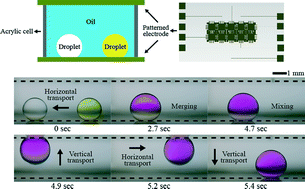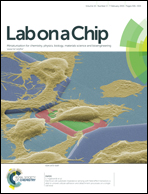Detaching droplets in immiscible fluids from a solid substrate with the help of electrowetting†
Abstract
The detachment (or removal) of droplets from a solid surface is an indispensable process in numerous practical applications which utilize digital microfluidics, including cell-based assay, chip cooling, and particle sampling. When a droplet that is fully stretched by impacting or electrowetting is released, the conversion of stored surface energy to kinetic energy can lead to the departure of the droplet from a solid surface. Here we firstly detach sessile droplets in immiscible fluids from a hydrophobic surface by electrowetting. The physical conditions for droplet detachment depend on droplet volume, viscosity of ambient fluid, and applied voltage. Their critical conditions are determined by exploring the retracting dynamics for a wide range of driving voltages and physical properties of fluids. The relationships between physical parameters and dynamic characteristics of retracting and jumping droplets, such as contact time and jumping height, are also established. The threshold voltage for droplet detachment in oil with high viscosity is largely reduced (~70%) by electrowetting actuations with a square pulse. To examine the applicability of three-dimensional digital microfluidic (3D-DMF) platforms to biological applications such as cell culture and cell-based assays, we demonstrate the detachment of droplets containing a mixture of human umbilical vein endothelial cells (HUVECs) and collagen (concentration of 4 × 104 cells mL−1) in silicone oil with a viscosity of 0.65 cSt. Furthermore, to complement the technical limitations due to the use of a needle electrode and to demonstrate the applicability of the 3D-DMF platform with patterned electrodes to chemical analysis and synthesis, we examine the transport, merging, mixing, and detachment of droplets with different pH values on the platform. Finally, by using DC and AC electrowetting actuations, we demonstrate the detachment of oil droplets with a very low contact angle (<~13°) in water on a hydrophobic surface.


 Please wait while we load your content...
Please wait while we load your content...